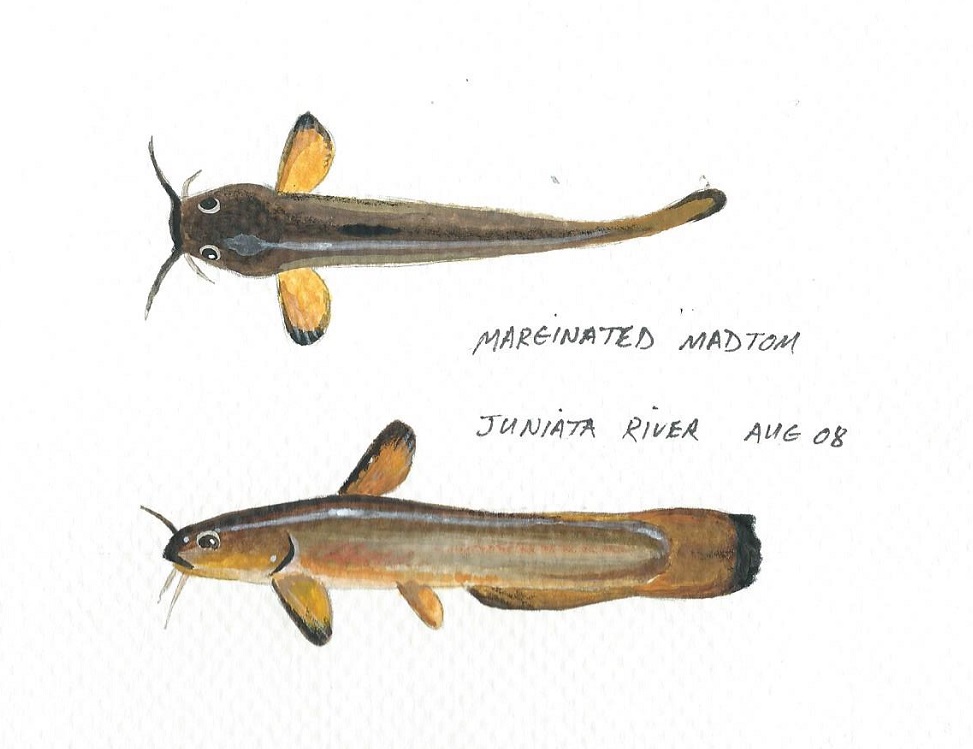In a recent stream report I indicated using a "stonecat" fly. For many PA FFers, this is an unusual pattern and not typically associated with trout fishing. Local river folks who fish bait for smallies, however, are very familiar with this critter.
The term "stonecat" is actually a misnomer and refers to a madtom found in western PA. The fish we have in the Susky/Potomac watershed is actually the marginated madtom. However, local folks have always called marginated madtoms "stonecats." Afishinado will tell you that locals in his home stomping grounds around Wilkes Barre call 'em "catties." They're a popular live bait.

Stonecat
Marginated madtoms are a shy, mysterious, largely nocturnal little catfish and many river anglers have never seen one. Bait fishermen often get them by seining weedy riffle areas at night or carefully feeling for them under rocks with their hands. Bass eat 'em like candy and, in my opinion, really key on the image of a stonecat. I love 'em, and stonecat flies are go-to patterns for summer bass for me, especially in clear water.
The fly I was using is one of a series of flies I've designed utilizing paint and craft felt. Like many of my personal patterns, it is realistic and detailed.
A much easier stonecat pattern would be tan or light brown sculpin wool for the head, a tan fur or chenille body, and a long tail of tan marabou. Tie a dumbbell weight Clouser style under the head so the fly swims hook upward and trim the head flat. Rubber band whiskers add a nice touch. The key, however, is to keep the fly very slender and very long.
Marginated madtoms are usually 2-5" in length and have a paddle like tail with a black edge; body is usually pinkish yellow on the ventral, light brown on the flanks, and olive over the back. You want a fly that swims with lots of motion and gets deep. I tie medium and very heavy versions.
The image above is an illustration I did of marginated madtoms based on a group of specimens I caught in central PA. Note the slender body, rounded tail that blends into the body like an eel, yellow fins, and square head with short whiskers.
You can follow the comments in the forum here on Stonecats.
The term "stonecat" is actually a misnomer and refers to a madtom found in western PA. The fish we have in the Susky/Potomac watershed is actually the marginated madtom. However, local folks have always called marginated madtoms "stonecats." Afishinado will tell you that locals in his home stomping grounds around Wilkes Barre call 'em "catties." They're a popular live bait.

Stonecat
Marginated madtoms are a shy, mysterious, largely nocturnal little catfish and many river anglers have never seen one. Bait fishermen often get them by seining weedy riffle areas at night or carefully feeling for them under rocks with their hands. Bass eat 'em like candy and, in my opinion, really key on the image of a stonecat. I love 'em, and stonecat flies are go-to patterns for summer bass for me, especially in clear water.
The fly I was using is one of a series of flies I've designed utilizing paint and craft felt. Like many of my personal patterns, it is realistic and detailed.
A much easier stonecat pattern would be tan or light brown sculpin wool for the head, a tan fur or chenille body, and a long tail of tan marabou. Tie a dumbbell weight Clouser style under the head so the fly swims hook upward and trim the head flat. Rubber band whiskers add a nice touch. The key, however, is to keep the fly very slender and very long.
Marginated madtoms are usually 2-5" in length and have a paddle like tail with a black edge; body is usually pinkish yellow on the ventral, light brown on the flanks, and olive over the back. You want a fly that swims with lots of motion and gets deep. I tie medium and very heavy versions.
The image above is an illustration I did of marginated madtoms based on a group of specimens I caught in central PA. Note the slender body, rounded tail that blends into the body like an eel, yellow fins, and square head with short whiskers.
You can follow the comments in the forum here on Stonecats.




